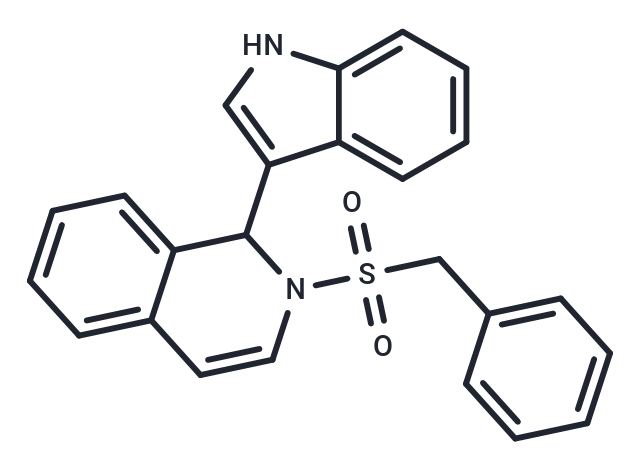Shopping Cart
- Remove All
 Your shopping cart is currently empty
Your shopping cart is currently empty

IBR2 (Isoquinoline) is a potent and specific RAD51 inhibitor known for its ability to suppress RAD51-mediated DNA double-strand break repair. By interfering with RAD51 multimerization, accelerating proteasome-mediated RAD51 protein degradation, inhibiting cancer cell growth, and inducing apoptosis, IBR2 has proved to be an effective compound in these aspects.

| Pack Size | Price | Availability | Quantity |
|---|---|---|---|
| 1 mg | $30 | In Stock | |
| 5 mg | $64 | In Stock | |
| 10 mg | $113 | In Stock | |
| 25 mg | $193 | In Stock | |
| 50 mg | $272 | In Stock | |
| 100 mg | $378 | In Stock | |
| 200 mg | $559 | In Stock | |
| 1 mL x 10 mM (in DMSO) | $70 | In Stock |
| Description | IBR2 (Isoquinoline) is a potent and specific RAD51 inhibitor known for its ability to suppress RAD51-mediated DNA double-strand break repair. By interfering with RAD51 multimerization, accelerating proteasome-mediated RAD51 protein degradation, inhibiting cancer cell growth, and inducing apoptosis, IBR2 has proved to be an effective compound in these aspects. |
| Targets&IC50 | RAD51:14.8 µM(triple-negative human breast cancer cell line MBA-MD-468) |
| In vitro | IBR2 can inhibit the growth of triple-negative human breast cancer cell line MBA-MD-468 with IC50 of 14.8 μM. IBR2 shows interesting RAD51 inhibition activities. RAD51 is rapidly degraded in IBR2-treated cancer cells, and the homologous recombination repair is impaired, subsequently leading to cell death. The IC50 values of the original IBR2 are in the range of 12-20 μM for most tested cancer cell lines[1]. |
| Alias | Isoquinoline |
| Molecular Weight | 400.49 |
| Formula | C24H20N2O2S |
| Cas No. | 313526-24-8 |
| Smiles | O=S(=O)(Cc1ccccc1)N1C=Cc2ccccc2C1c1c[nH]c2ccccc12 |
| Relative Density. | 1.38 g/cm3 (Predicted) |
| Storage | Powder: -20°C for 3 years | In solvent: -80°C for 1 year | Shipping with blue ice. | |||||||||||||||||||||||||||||||||||
| Solubility Information | DMSO: 100 mg/mL (249.69 mM), Sonication is recommended. | |||||||||||||||||||||||||||||||||||
Solution Preparation Table | ||||||||||||||||||||||||||||||||||||
DMSO
| ||||||||||||||||||||||||||||||||||||

Copyright © 2015-2025 TargetMol Chemicals Inc. All Rights Reserved.